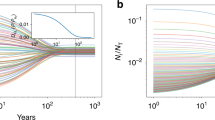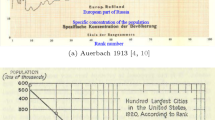Abstract
It is largely accepted among geographers and economists that the City Size Distribution (CSD) is well described by a power law, i.e., Zipf’s law. This opinion is shared by this community in a manner it could be treated as a paradigm. In reality, however, Zipf’s law is not always observed (even as an approximation), and we prefer to adopt a classification of the CSD into three classes. In this work, we present the characteristics of these classes and give some examples for them. We use the Israeli system of cities as an interesting case study in which the same ensemble of cities passes from one class to another. We relate this change to the urbanization process that occurred in Israel from the 1960s onwards.








Similar content being viewed by others
Notes
Sometimes a difference is made between the "rank–size rule" for which the value of the exponent of the rank–size graph is −1 and the other cases where the exponent is different from −1. These last situations are called "Zipf's law". Here we do not make this distinction. We refer to all the cases of power law as "Zipf's law".
We use the term because the best example of the method is given in the article by Laherrere and Sornette, published in a physics journal.
All the data in this work are taken from: www.citypopulation.de.
We chose the cutoff of 1,000 inhabitants because the complete rank–size curve can be divided in two parts separated by a sudden change in the slope. Following the suggestion developed above, we divided the cities into two distinct groups.
We think that a meaningful study of a distribution must be done using the three representations of a distribution (see “Appendix 1”).
References
Alperovich G (1984) The size distribution of cities: on the empirical validity of the rank–size rule. J Urban Econ 16(2):232–249
Alperovich G (1988) A new testing procedure of the rank size distribution. J Urban Econ 23(2):251–259
Alperovich G, Deutsch J (1995) The size distribution of urban areas: testing for the appropriateness of the Pareto distribution using a generalized box-cox transformation function. J Reg Sci 35(2):267–278
Benguigui L, Blumenfeld-Lieberthal E (2006) From lognormal distribution to power law: a new classification of the size distributions. Int J Mod Phys C 17(10):1429–1436
Benguigui L, Blumenfeld-Lieberthal E (2007a) A new classification of city size distributions. Comput Environ Urban Syst 31(6):648–666
Benguigui L, Blumenfeld-Lieberthal E (2007b) A dynamic model for the city size distribution beyond zipf’s law. Physica A 384(2):613–627
Gabaix X (1999) Zipf’s law for cities: an explanation. Quart J Econ 114(3):739–767
Gabaix X, Ioannides YM (2004) The evolution of city size distributions. In: Henderson JV, Thisse JF (eds) Handbook of urban and regional economics 4. Amsterdam Elsevier Science, Amsterdam, pp 2341–2378
Gabaix X, Gopikrishnan P, Plerou V, Stanley HE (2003) A theory of power law distributions in financial market fluctuations. Nature 423:267–270
Jefferson M (1939) The law of primate city. Geogr Rev 29:226–232
Krugman P (1996) Self organizing economy. Blackwell Publishers, Oxford
Kuhn TS (1977) The essential tension. Selected studies in scientific tradition and change. University of Chicago Press, Chicago
Laherrere J and Sornette D (1998) Stretched exponential distributions in nature and economy: “fat tails” with characteristic scales. Eur J Phys B2 2(4):525–539
Li W (2002) Zipf’s law everywhere. Glottometrics 5:14–21 (despite the title, the author considers situations in which the law is not valid)
Nishiyama Y, Osada S, Sato Y (2008) OLS estimation and the t test revisited in rank–size rule regression. J Reg Sci 48(4):691–715
Par JB (1973) Settlement populations and the lognormal distribution. Urban Stud 10(3):336–352
Par JB (1976) A class of deviations from rank–size regularity: three interpretations. Reg Stud 10(3):285–292
Par JB (1985) A note on the size distribution of cities over time. J Urban Econ 18(2):199–212
Popescu II (2003) On a Zipf’s law extension to impact factors. Glottometrics 6:83–93
Rosen KT, Resnick M (1980) The size distribution of cities: an examination of the Pareto law and primacy. J Urban Econ 8(2):165–186
Soo KT (2005) Zipf’s law for cities: a cross country investigation. Reg Sci Urban Econ 35(3):239–263
Urzua CM (2000) A simple and efficient test for Zipf’s law. Econ Lett 66(3):257–260
Zipf GK (1941) National unity and disunity. The Principia Press, Bloomington
Zipf GK (1949) Human behavior and the principle of least effort. Addison-Wesley, Inv, Cambridge
Acknowledgments
The authors thank George Kun of the Central Bureau of Statistics of Israel for providing the data of the cities of Israel and useful discussions.
Author information
Authors and Affiliations
Corresponding author
Appendix
Appendix
To illustrate the discussion on the verification of Zipf’s law, we present two different cases: the classical case of Zipf’s law, a case where the CSD is better fitted with another function rather than the straight line.
The first case is given in Fig. 2 which presents the straight line of the fit after excluding the agglomeration with population smaller than 200,000 from the distribution. The Zipf exponent m is equal to 0.918 and R 2 = 0.995. The quality of the fit is examined through the statistics of the errors. It is defined as the differences between the real data and the values calculated from the fit function. For a good fit we expect that:
-
1.
The mean of the errors will be relatively small to the total range of the errors.
-
2.
The errors will be randomly distributed on the both side of the origin.
-
3.
The error distribution will be close to a normal one with a single and clear maximum.
In the case of India, the mean of the errors is −0.0023; when the range is 0.8, the distribution of the errors is not an exact normal distribution but a good approximation of it. Thus, it can be argued that Zipf’s law is verified but with an exponent different from unity.
The second case is the metropolitan area of the USA. Its rank–size plot is presented in Fig. 9. A fit with a straight line gives a large value of R 2 = 0.9981 with m = 1.06. The statistics of the errors give the following results: mean = 2 × 10−3, standard deviation = 0.145 and range = 1.37, and the distribution is far from being a normal one as it has two maxima. The graph of the errors as a function of the log of the rank is very close to a parabola; this means that errors are not equally placed on both sides of the origin.
Rank–size plot of the metropolitan areas of the USA. The curve is the fit with a parabola or with Eq. 2 (there is no visible difference between the two fits)
A fit of the data to a parabola or to Eq. 2 yielded almost the same results; the parabola is described by the parameters: y = 16.565−0.326 x−0.919 x 2, and Eq. 2 is described by: y = 16.67−0.146 (1.02 + x)1.85. The coefficient of determination, R 2 = 0.9984, is a little bit higher than in the precedent fit, but it has no significance. The statistics of the errors, however, give very different results: mean = 0.001, standard deviation = 0.0403 and range = 0.490, and the distribution is close to a normal one with a single maximum near zero. Even more interesting is the graph of the errors as a function of the log of the rank: the errors are equally distributed on both sides of the origin. We conclude that the fit with a parabola or with Eq. 2 is better than a straight line despite the very close values of R 2. In Fig. 9 we present the fit of the data with Eq. 2, and in the insert we present the errors. We admit that with a visual inspection only, it was also possible to reject Zipf’s law in this case.
Rights and permissions
About this article
Cite this article
Benguigui, L., Blumenfeld-Lieberthal, E. The end of a paradigm: is Zipf’s law universal?. J Geogr Syst 13, 87–100 (2011). https://doi.org/10.1007/s10109-010-0132-6
Received:
Accepted:
Published:
Issue Date:
DOI: https://doi.org/10.1007/s10109-010-0132-6





